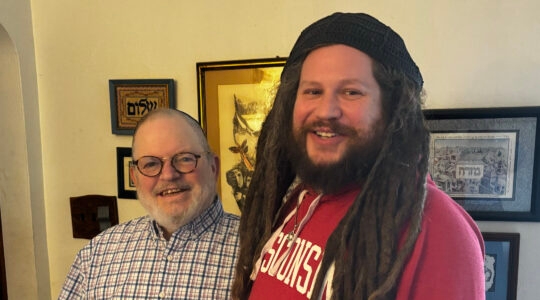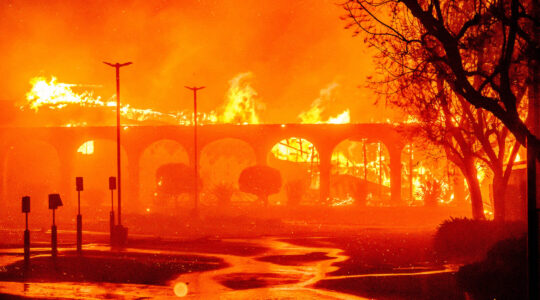SAN FRANCISCO (JTA) — After the Reform movement broadcast online its first session devoted to reassessing itself, in mid-November, the comments poured in.
One viewer suggested that the movement create a network of schools, camps, shuls and seminaries focused on “tikkun olam,” the Jewish injunction to repair the world. Another said the movement should train five times as many rabbis and cantors to provide more entryways into Judaism through music, social action and prayer.
Another wrote to express concern about the lack of civility in Jewish discourse, particularly concerning Israel. One asked how Jews could use media and technology to create community.
It is exactly the sort of grass-roots input that members of the reassessment team, called the Reform Think Tank, want as they take a hard look at where American Jewry’s largest religious denomination is today and where it ought to go in the future.
“Five years from now, congregations won’t look like they do today,” said Rabbi Eric Yoffie, the longtime president of the Union for Reform Judaism, told JTA in an interview.
Yoffie, who plans to retire in mid-2012, is one of the major players in the movement’s reassessment project.
The project is online and offline, top down and bottom up. Each of the three major Reform institutions — the synagogue movement, rabbinical association and seminary — nominated 10 members to lead the 18-month discussion, which will be punctuated by four live streaming forums devoted to specific topics. Each is being archived online at urj.org/thinktank.
The first, held Nov. 21 in Los Angeles, dealt with the impact of social media on religious life. About 300 individual viewers watched in addition to about 50 watching parties at Reform congregations. They could follow a blog and Twitter feed along with the broadcast, and sent in comments and questions to help direct the conversation. The team received more than 200 comments and questions even before the first forum, an organizer said.
The second forum is scheduled for April in Cincinnati, a third for December 2011, and the final for March 2012.
“We’ve never done anything like this before,” Yoffie said.
“It’s kind of scary,” said Steven Windmueller, a professor at the School of Jewish Communal Service at Hebrew Union College-Jewish Institute of Religion in Los Angeles and one of the co-organizers of the project. “Everything’s on the table. If we reinvent this whole thing, what will it look like? We’re not moving from one place to another in linear fashion — we’re experimenting.”
Demographic changes, financial challenges, new family structures and the changing nature of social media and how people connect to each other are just some of the pressures forcing change upon a movement founded 200 years ago in Germany but that developed its institutions in North America following World War II, Yoffie said.
Back then, the world and American Jewry had different needs and interests, he said.
“We are primarily a suburban, family-oriented movement,” Yoffie told JTA.
That’s one thing that must change if Reform Judaism is to appeal to the next generation, according to Yoffie.
“We need more synagogues in the major metropolitan centers,” he said.
The recent economic downturn already has forced changes, including the dismantling of much of the Union for Reform Judaism itself, where consultants have replaced many staff departments. That was in the works already, Reform leaders insist; the recession just advanced the move quicker and gives a greater urgency to the reassessment project.
“This is not an ivory tower think tank,” said Rachel Tasch, president of Congregation Beth Am in Los Altos Hills, Calif., and one of the 33 leaders selected for the Reform Think Tank. “We’re trying to make it a grass-roots thing, so people have a voice, a way to have real input.”
Those who want to participate in the project can send in their comments anytime over the next year and a half. Pulpit rabbis involved with the project will take the conversation to their congregations and “take the pulse of the community” before the next forum, Windmueller said. The team also will consult with youth groups, synagogue presidents and other Reform activists.
“Most of the questions we received were in line with the questions we ourselves have,” Tasch said after the first forum. “The nature of community in a world where everything is online; the tension between face-to-face communication and technology; the nature of membership; what does it mean to belong in a world where everything is out there and available?”
Yoffie believes that synagogues will continue to be the foundation of Jewish life in North America but must evolve radically to adjust to how people communicate and relate via technology.
“Social media can be contentious,” he told JTA, “and congregations are not contentious places. It’s where you go for comfort and support. So how do we deal with the contention of modern media while preserving the congregation as a place of menschlikeit and mutual respect?
“The truth is, we have to take risks if we’re not going to be irrelevant.”
JTA has documented Jewish history in real-time for over a century. Keep our journalism strong by joining us in supporting independent, award-winning reporting.





